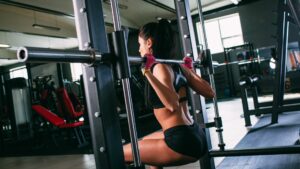Hey there, fitness enthusiasts! Have you ever wondered if it’s possible to conquer 50 squats in a row with a Smith machine? Well, you’re in for a treat because in this blog post, we’re diving deep into this challenging fitness goal.
Whether you’re a seasoned lifter or just starting your journey to strength, we’ll explore the factors that determine your ability to achieve this feat, share some expert tips, and uncover the secrets to mastering the Smith machine squat.
So, let’s get those glutes firing and those quads pumping – because the road to 50 squats starts right here!
Understanding whether or not to do 50 squats in a row with a Smith machine.
Whether or not you can do 50 squats in a row with a Smith machine depends on your fitness level, strength, and endurance.
Here are some things to consider though:
let’s break down the statement “fitness level, strength, and endurance“:
Fitness Level.
Fitness level refers to your overall physical condition and how well your body has adapted to regular exercise.
If you have been consistently training and have a high fitness level, you are more likely to have the cardiovascular endurance, muscular strength, and stamina needed to perform 50 squats in a row.
On the other hand, if you are relatively new to exercise or have not focused on lower body strength, it may be more challenging to achieve this goal.
Strength.
Strength is a key factor in performing squats. The squat is a compound exercise that engages multiple muscle groups, including the quadriceps, hamstrings, glutes, and lower back.
The amount of weight you can squat and the number of reps you can perform depends on your strength levels.
If you can squat a heavier weight with proper form, you are more likely to be able to do more repetitions.
Endurance.
Endurance refers to your ability to sustain an activity over an extended period.
Performing 50 squats in a row requires muscular endurance, particularly in the leg muscles.
Your muscles need to be able to contract repeatedly without fatigue to complete this many reps.
Endurance training helps improve your stamina, allowing you to perform a higher number of repetitions without exhaustion.
In other words, whether or not you can do 50 squats in a row with a Smith machine depends on your fitness level, which encompasses your overall physical condition, your strength, which determines the weight and reps you can handle, and your endurance, which allows you to sustain the exercise for an extended period.
Achieving this goal typically requires consistent training and gradual progression to build the necessary strength and endurance.
Additionally, factors like age, genetics, and prior exercise experience can also play a role in determining your ability to perform 50 consecutive squats.
General tips to help you work towards that goal:
Warm-Up: Always start with a proper warm-up to prepare your muscles and joints for the exercise.
A few minutes of light cardio and dynamic stretching can help.
Proper Form: Maintain good squat form to prevent injury. Stand with your feet shoulder-width apart, with the barbell resting on your upper back.
Keep your chest up, back straight, and core engaged.

Depth: Lower your body until your thighs are parallel to the ground or lower if you can while maintaining good form.
Make sure your knees don’t go past your toes.
Breathing: Inhale as you lower yourself, and exhale as you push back up.
This helps stabilize your core and maintain proper form.
Gradual Progression: If you’re aiming for 50 squats in a row, start with a weight that you can comfortably handle for a set of 8-10 reps.
Gradually increase the weight and the number of reps as you build strength and endurance.
Rest: Take short breaks between sets if needed to maintain your form and prevent fatigue-induced injuries.
Safety: Always use a spotter or safety bars when using a Smith machine to ensure safety.
Listen to Your Body: Pay attention to any pain or discomfort.
If you experience pain, stop immediately and seek guidance from a fitness professional.
Remember that achieving 50 squats in a row is a challenging goal and may take time and consistent training to accomplish.
It’s essential to prioritize safety, proper form, and gradual progression in your training routine.
Consulting with a fitness trainer or coach can also be beneficial in helping you reach your specific fitness goals.
Further explanations.
Let’s dive deeper and elaborate further on all the points mentioned.
let’s break down the importance of each of these points when performing squats with a Smith machine:
Warming-Up:
Purpose:
A proper warm-up is essential to gradually increase your heart rate, raise your body temperature, and prepare your muscles and joints for more intense exercise.
It helps reduce the risk of injury and enhances exercise performance.
Explanation:
When you start your workout with light cardio (like jogging in place or jumping jacks) and dynamic stretching (stretching that involves movement), you increase blood flow to your muscles, improve joint mobility, and activate the nervous system. This primes your body for the squatting motion.
Proper Form:
Purpose:
Maintaining good squat form is crucial to prevent injuries and maximize the effectiveness of the exercise.
Explanation:
When you squat with proper form, you distribute the load evenly across your muscles and joints.
Standing with your feet shoulder-width apart provides a stable base, and having the barbell on your upper back ensures it’s properly supported.
Keeping your chest up and back straight helps prevent excessive forward leaning, which can strain your lower back. Engaging your core stabilizes your spine during the squat, promoting safety and balance.

Depth:
Purpose:
Achieving the correct depth during a squat ensures that you engage the targeted muscles effectively and avoid unnecessary strain on your knees.
Explanation:
Lowering your body until your thighs are parallel to the ground or even lower (known as a deep squat) helps engage your quadriceps, hamstrings, and glutes optimally.
It also enhances flexibility and mobility in your hip and ankle joints.
Ensuring that your knees don’t go past your toes helps prevent excessive stress on the knee joint and maintains balance during the movement.
Breathing:
Purpose:
Proper breathing during squats helps stabilize your core, maintain intra-abdominal pressure, and ensure that you’re using your diaphragm effectively.
Explanation:
Inhaling as you lower yourself into the squat allows you to fill your lungs with air, creating a stable core and providing support to your spine.
As you exhale while pushing back up, you maintain core stability and prevent your torso from collapsing forward.
This controlled breathing pattern helps you maintain balance, control, and proper form throughout the exercise.
In all this is that following these guidelines when performing squats with a Smith machine is crucial for safety, effectiveness, and overall performance.
A proper warm-up prepares your body for exercise, maintaining good form reduces the risk of injury, achieving the correct depth engages the right muscles, and proper breathing helps stabilize your core and maintain balance throughout the movement.
These practices collectively contribute to a safe and productive squatting experience.
Let’s dive deeper into the significance of these points when aiming to perform 50 squats in a row with a Smith machine:
Gradual Progression:
Purpose:
Gradually increasing the weight and repetitions is essential to build the strength and endurance required for 50 consecutive squats.
Explanation:
Starting with a weight that you can comfortably handle for 8-10 reps allows you to establish a solid foundation of strength and proper form.
As you become more proficient and your muscles adapt, you can incrementally increase the weight and the number of repetitions.
This progressive overload stimulates muscle growth and improves endurance over time. Sudden or excessive increases in weight or reps can lead to injury or muscle fatigue.
Rest:
Purpose:
Taking short breaks between sets is vital to maintain form and prevent fatigue-induced injuries.
Explanation:
Rest intervals between sets allow your muscles to partially recover and reduce the risk of fatigue-related accidents, such as losing control of the barbell.
Short breaks also help maintain the quality of your squats by ensuring that you can maintain proper form throughout each set.
The length of these breaks may vary depending on your fitness level and the intensity of your workout, but they should be sufficient to allow you to perform your next set safely.
Safety.
Purpose:
Using a spotter or safety bars when using a Smith machine is essential to ensure safety during heavy lifts.
Explanation:
The Smith machine provides stability and guidance, but accidents can still happen, especially when pushing the limits of your strength and endurance.
Having a spotter or setting up safety bars at an appropriate height can prevent the barbell from falling on you if you reach muscle failure or encounter balance issues during a squat.
Safety should always be a top priority when lifting heavy weights.
Listen to Your Body:
Purpose:
Paying attention to your body’s signals, especially pain or discomfort, is crucial to prevent injury and ensure long-term health.
Explanation:
Your body communicates through sensations like pain or discomfort. If you experience sharp or persistent pain while squatting, it’s a signal that something may be wrong, such as improper form or an underlying injury.
Ignoring these signals can lead to serious injuries. If you do experience pain, it’s essential to stop immediately, assess the issue, and, if necessary, seek guidance from a fitness professional or healthcare provider. Pushing through pain can exacerbate the problem and lead to more severe injuries.
In essense, these principles are fundamental to safe and effective strength training with a Smith machine.
Gradual progression ensures steady improvements in strength and endurance, proper rest intervals maintain form and prevent overexertion, safety measures reduce the risk of accidents, and listening to your body helps prevent injuries by responding to warning signs promptly. Together, these practices contribute to a sustainable and injury-free fitness journey.
A tabular on this topic here.
Here’s a tabular representation of whether one can do 50 squats in a row with a Smith machine, considering different fitness levels and training progressions:
| Fitness Level / Training Progression | Ability to Do 50 Squats in a Row with a Smith Machine |
|---|---|
| Beginner | Unlikely, as beginners typically lack the strength and endurance to perform 50 consecutive squats. They may need to start with lower weights and fewer reps. |
| Intermediate | Possible with dedicated training and progression. Intermediate lifters may work their way up to 50 squats by gradually increasing weight and reps over time. |
| Advanced | More likely, as advanced lifters have developed the strength and endurance required. They may already be able to perform 50 squats in a row or can achieve this goal with focused training. |
It’s important to note that individual results may vary based on factors like age, genetics, and prior training experience.
Additionally, safety and proper form should always be a priority when performing any exercise, especially with heavy weights on a Smith machine.
Conclusion.
In conclusion, the ability to perform 50 squats in a row with a Smith machine depends on an individual’s fitness level, training progression, and dedication to proper form and safety.
Beginners may find it challenging and need to start with lower weights and reps, while intermediate and advanced lifters can work their way up to this goal through gradual progression.
Regardless of fitness level, safety and form should always be a top priority during strength training.

Hey there, it’s Mike Rrsq, the Editor-in-Chief over at Jsquat.com, and I’m absolutely obsessed with all things squat fitness! I’ve been lucky enough to get some serious recognition for my work in this field. With a solid background in the fitness and wellness industry, I’ve been there right from the get-go, helping shape this website into what it is today.
You see, I’m not just the boss around here; I’m also a passionate contributor. I love sharing my insights through my articles, and trust me, they’re not your run-of-the-mill stuff. Each piece I write is a labor of love, filled with my expertise and real-world experience in the fitness universe. So, if you’re into fitness and looking for some inspiration, you’re in the right place!

